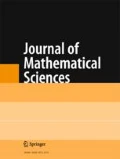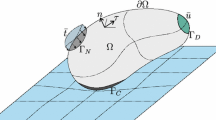We propose a combined algorithm for the solution of the problems of contact of elastic bodies. This algorithm combines the iterative method of domain decomposition and the h -adaptive scheme based on the comparison of the results of the finite-element and boundary-element methods. The numerical analysis of a test problem shows that the mesh refinement performed by using the proposed algorithm reveals singularities of the stress field near the contact area and the total number of unknowns significantly decreases, as compared with the case of uniform partition.
Similar content being viewed by others
References
I. I. Vorovich, V. M. Aleksandrov, and V. A. Babeshko, Nonclassical Mixed Problems of the Theory of Elasticity [in Russian], Nauka, Moscow (1974).
A. Ya. Grigorenko, I. I. Dyyak, S. I. Matysyak, and I. I. Prokopyshyn, “Domain decomposition methods applied to solve frictionless-contact problems for multilayer elastic bodies,” Prikl. Mekh., 46, No. 4, 25–37 (2010); English translation: Int. Appl. Mech., 46, No. 4, 388–399 (2010).
A. Ya. Grigorenko, I. I. Dyyak, and I. I. Prokopyshyn, “Domain decomposition method with hybrid approximations applied to solve problems of elasticity,” Prikl. Mekh., 44, No. 11, 18–29 (2008); English translation: Int. Appl. Mech., 44, No. 11, 1213–1222 (2008).
I. I. Dyyak and I. I. Prokopyshyn, “Convergence of the Neumann parallel scheme of the domain decomposition method for problems of frictionless contact between several elastic bodies,” Mat. Met. Fiz.-Mekh. Polya, 52, No. 3, 78–89 (2009); English translation: J. Math. Sci., 171, No. 4, 516–533 (2010).
I. Dyyak and Yu. Yashchuk, “A finite boundary-element estimator of errors of the finite-element method for elasticity problems,” Visn. Lviv. Univ. Ser. Prykl. Mat. Inf., Issue 19, 47–55 (2013).
A. S. Kravchuk, “Statement of the problem of contact of several deformable bodies as a problem of nonlinear programming,” Prikl. Mat. Mekh., 42, No. 3, 467–474 (1978).
V. I. Kuz’menko, “On the variational approach to the theory of contact problems for nonlinearly elastic laminated bodies,” Prikl. Mat. Mekh., 43, No. 5, 893–901 (1979).
A. I. Lur’e, Elasticity Theory [in Russian], Nauka, Moscow, 1970.
I. I. Prokopyshyn, I. I. Dyyak, and R. M. Martynyak, “Numerical analysis of the problems of contact of three elastic bodies by the domain decomposition methods,” Fiz.-Khim. Mekh. Mater., 49, No. 1, 46–55 (2013); English translation: Mater. Sci., 49, No. 1, 45–58 (2013).
M. Ainsworth and J. T. Oden, A Posteriori Error Estimation in Finite Element Analysis, Wiley, New York (2000).
P. Avery and C. Farhat, “The FETI family of domain decomposition methods for inequality-constrained quadratic programming: Application to contact problems with conforming and nonconforming interfaces,” Comput. Meth. Appl. Mech. Eng., 198, 1673–1683 (2009).
G. C. Buscaglia, R. Duran, E. A. Fancello, R. A. Feijoo, and C. Padra, “An adaptive finite element approach for frictionless contact problems,” Int. J. Numer. Meth. Eng., 50, 395–418 (2001).
J. Céa, Optimisation: Théorie et Algorithmes, Dunod, Paris (1971).
I. Dyyak, S. Matysiak, and Yu. Yashchuk, “FEM-BEM based error estimator in elasticity problems,” in: Proc. of the 19 th Internat. Conf. on Comput. Meth. in Mech. Short Papers, Warszawa (2011), pp. 175–176.
I. I. Dyyak, I. I. Prokopyshyn, and I. A. Prokopyshyn, “Penalty Robin–Robin domain decomposition methods for unilateral multibody contact problems of elasticity: Convergence results,” http://arxiv.org/pdf/1208.6478.pdf, 2012.
D. Franke, A. Düster, V. Nübel, and E. Rank, “A comparison of the h -, p -, hp -, and rp -version of the FEM for the solution of the 2D Hertzian contact problem,” Comput. Mech., 45, No. 5, 513–522 (2010).
L. Gallimard and T. Sassi, “A posteriori error analysis of a domain decomposition algorithm for unilateral contact problem,” Comput. Struct., 88, 879–888 (2010).
J. Haslinger, R. Kučera, and T. Sassi, “A domain decomposition algorithm for contact problems: Analysis and implementation,” Math. Model. Nat. Phenom., 4, No. 1, 123–146 (2009).
I. Hlavaček, J. Haslinger, J. Nečas, and J. Lovišek, Solution of Variational Inequalities in Mechanics, Springer, New York (1988), Ser. Appl. Math. Sci., Vol. 66.
A. M. Khludnev and V. A. Kovtunenko, Analysis of Cracks in Solids, WIT Press, Southampton, Boston (2000).
N. Kikuchi and J. T. Oden, Contact Problems in Elasticity: A Study of Variational Inequalities and Finite Element Methods, SIAM, Philadelphia (1988).
J. Koko, “Uzawa block relaxation domain decomposition method for a two-body frictionless contact problem,” Appl. Math. Lett., 22, 1534–1538 (2009).
A. Kravchuk and P. Neittaanmaki, Variational and Quasi-Variational Inequalities in Mechanics, Springer, Dordrecht (2007).
J.-L. Lions, Quelques Méthodes de Résolution des Problèmes aux Limites Non Linéaires, Dunod, Paris (1969).
I. I. Prokopyshyn, I. I. Dyyak, R. M. Martynyak, and I. A. Prokopyshyn, “Penalty Robin–Robin domain decomposition schemes for contact problems of nonlinear elasticity,” in: Lect. Notes Comput. Sci. Eng., Vol. 91, (2013), pp. 647–654.
B. Wohlmuth, “A mortar finite element method using dual spaces for the Lagrange multiplier,” SIAM J. Numer. Anal., 38, No. 3, 989–1012 (2000).
B. Wohlmuth, “Variationally consistent discretization schemes and numerical algorithms for contact problems,” Acta Numer., 20, 569–734 (2011).
P. Wriggers, Computational Contact Mechanics, Springer, Berlin (2006).
P. Wriggers, “Finite element algorithms for contact problems,” Arch. Comput. Meth. Eng., 2, No. 4, 1–49 (1995).
P. Wriggers and O. Scherf, “Different a posteriori error estimators and indicators for contact problems,” Math. Comput. Model., 28, Nos. 4–8, 437–447 (1998).
Author information
Authors and Affiliations
Additional information
Translated from Matematychni Metody ta Fizyko-Mekhanichni Polya, Vol. 56, No. 4, pp. 96–109, October–December, 2013.
Rights and permissions
About this article
Cite this article
Dyyak, I.I., Prokopyshyn, I.I. & Yashchuk, Y.O. Combined Algorithm of Domain Decomposition and h -Adaptation for the Solution of Contact Problems of Elasticity. J Math Sci 208, 383–399 (2015). https://doi.org/10.1007/s10958-015-2453-y
Received:
Published:
Issue Date:
DOI: https://doi.org/10.1007/s10958-015-2453-y




